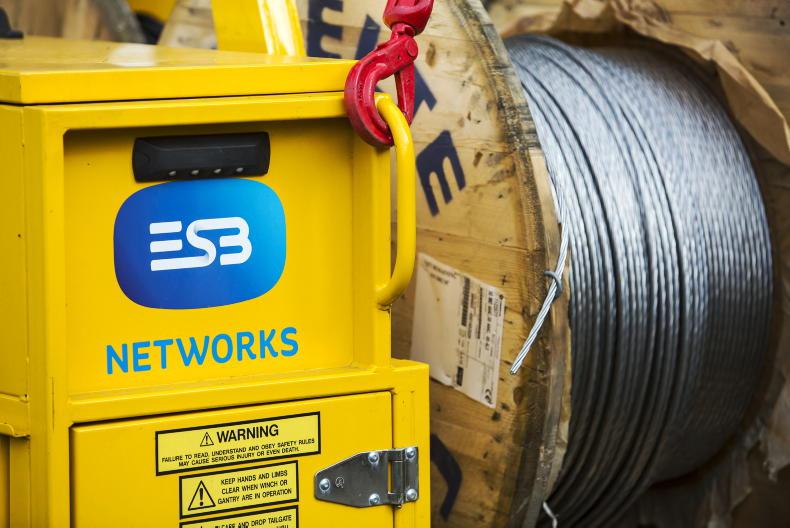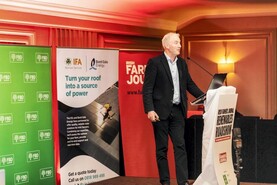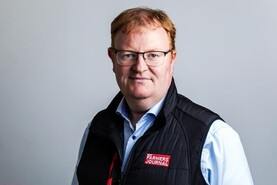When it comes to developing a renewable electricity project, getting connected to the national grid is critical.
Depending on the scale and nature of the project, the process can be straightforward or highly complex.
From the middle of 2021 onwards, farmers will be able to generate renewable electricity and sell surplus generation to the national electricity grid, meaning they must be connected to the grid.
The Government, ESB Networks and the Commission for Regulation of Utilities are currently developing a new connection process for micro-generators of between 11 kilowatts (kW) and 50kW in output.

Sustainable Farm Insights.
This is in order to make it easier for micro or small-scale generators to connect to the grid, but limited details have been released yet.
However, the process for connecting other renewable projects to the grid is well defined.
In a recent Teagasc farm business options webinar, senior consultant at MullanGrid Consulting Rory Mullan outlined the process and options for grid connections, as well as the key considerations before starting your project.
Size and type of generator
Rory outlined that the first step in the grid connection process, and perhaps the most obvious, is to consider the type and size of generator you want to connect. The size of the renewable development dictates the type of connection you will apply for.
For example, a rooftop domestic solar PV array with an output of 2.5kW has a straightforward connection procedure.
A solar farm with an output in excess of 5 megawatt (MW), which will connect to the grid to sell electricity, has a much more substantial and costly connection process.
To export or not export
Another consideration is to determine if you actually need to export electricity to the grid. There are significant opportunities to displace imported electricity on to farms by generating your own.
Given the scale and nature of the renewable system, there may not be much electricity available to export to the grid. This is called a zero-export connection and is much more straightforward, Rory explained.

Many farmers will likely apply to connect to the national electricity grid when the micro-generation scheme is launched later this year.
If you want to export to the grid, you will need to look for export capacity from ESB Networks and this is where it gets more complex.
Renewable projects where generation capacity is more than 40MW will typically apply to EirGrid. EirGrid is the transmission system operator for Ireland.
However, projects below 40MW will apply to ESB Networks to get connected to the distribution system (the grid).
When applying to ESB Networks for a grid connection, the project will have to fit into one of the six offer processes:
Micro-generation: micro-generation ranges from 6kW (single-phase) to 11kW (three-phase) generators and the process for connecting this capacity to the grid is relatively straightforward. Currently, there are around 18,000 micro-generators connected to the grid. Zero-export: the next process is for generators which are producing electricity for self-consumption and are not exporting to the grid. Generators in this category can be much larger in capacity. Even if not exporting to the grid, you must still apply to ESB Networks in order to connect to its system. This is a fairly straightforward process. Small-scale generation: the next level of connection is for generators with output ranging from 11kW to 500kW. Before applying, you must have planning permission secured for the generator. Auto-production: This category covers larger generators which are both using electricity on-site and exporting excess production to the grid. Before applying, you must have planning permission secured for the generator.Community projects: communities which come together to develop a new renewable project between 500kW and 5MW in capacity have a specific offer process. While Ireland currently has just a handful of operational community projects, many more are in development. Currently, communities do not need to have planning permission secured in order to apply for this connection, but they do need to be a registered SEAI community group. Large renewable project: The final offer process is for large renewable energy projects in excess of 500kW in output. The majority of Ireland’s wind farms have connected through this process. This connection procedure is known as a batch process, where ESB Networks and EirGrid process approximately 80 applications in a single batch. Planning permission is needed for the development before the connection can be applied for. This process covers all technology such as wind, solar, hydro, biomass or biogas.
Will my connection be feasible?
Rory explains that understanding if your grid connection will be feasible is like an onion, as there are many different layers to consider, including substation capacity, proximity to the grid and line voltage limits.
The grid is limited by capacity and this can greatly influence the feasibility of securing a grid connection. Over the past two decades, many renewables projects have connected to the grid, which limits its capacity for new generators.
Figure 1 shows the locations of high-voltage substations in the Republic of Ireland where grid capacity is already full (red). However, this is only one layer of the onion.

These substations will require substantial upgrades to accommodate additional generation.
Rory stressed that this doesn’t mean that more generation can’t be accommodated, but rather that the connection will be more expensive as upgrades will be required.
Generators’ proximity to the grid also influences the viability of the project. Smaller-scale generators in particular must be close to the grid, as the further the connection distance, the higher the cost.
The connection process varies depending on the scale and structure of your project. One of the first steps in any project is to complete a feasibility study.
The aim of this is to attempt to determine the feasibility of the connection before investing significant time and money needed to progress the project.
For medium to larger renewable projects, the cost of connecting the grid can be substantial, ranging from between €100,000 and €200,000 per MW of capacity.
When it comes to developing a renewable electricity project, getting connected to the national grid is critical.
Depending on the scale and nature of the project, the process can be straightforward or highly complex.
From the middle of 2021 onwards, farmers will be able to generate renewable electricity and sell surplus generation to the national electricity grid, meaning they must be connected to the grid.
The Government, ESB Networks and the Commission for Regulation of Utilities are currently developing a new connection process for micro-generators of between 11 kilowatts (kW) and 50kW in output.

Sustainable Farm Insights.
This is in order to make it easier for micro or small-scale generators to connect to the grid, but limited details have been released yet.
However, the process for connecting other renewable projects to the grid is well defined.
In a recent Teagasc farm business options webinar, senior consultant at MullanGrid Consulting Rory Mullan outlined the process and options for grid connections, as well as the key considerations before starting your project.
Size and type of generator
Rory outlined that the first step in the grid connection process, and perhaps the most obvious, is to consider the type and size of generator you want to connect. The size of the renewable development dictates the type of connection you will apply for.
For example, a rooftop domestic solar PV array with an output of 2.5kW has a straightforward connection procedure.
A solar farm with an output in excess of 5 megawatt (MW), which will connect to the grid to sell electricity, has a much more substantial and costly connection process.
To export or not export
Another consideration is to determine if you actually need to export electricity to the grid. There are significant opportunities to displace imported electricity on to farms by generating your own.
Given the scale and nature of the renewable system, there may not be much electricity available to export to the grid. This is called a zero-export connection and is much more straightforward, Rory explained.

Many farmers will likely apply to connect to the national electricity grid when the micro-generation scheme is launched later this year.
If you want to export to the grid, you will need to look for export capacity from ESB Networks and this is where it gets more complex.
Renewable projects where generation capacity is more than 40MW will typically apply to EirGrid. EirGrid is the transmission system operator for Ireland.
However, projects below 40MW will apply to ESB Networks to get connected to the distribution system (the grid).
When applying to ESB Networks for a grid connection, the project will have to fit into one of the six offer processes:
Micro-generation: micro-generation ranges from 6kW (single-phase) to 11kW (three-phase) generators and the process for connecting this capacity to the grid is relatively straightforward. Currently, there are around 18,000 micro-generators connected to the grid. Zero-export: the next process is for generators which are producing electricity for self-consumption and are not exporting to the grid. Generators in this category can be much larger in capacity. Even if not exporting to the grid, you must still apply to ESB Networks in order to connect to its system. This is a fairly straightforward process. Small-scale generation: the next level of connection is for generators with output ranging from 11kW to 500kW. Before applying, you must have planning permission secured for the generator. Auto-production: This category covers larger generators which are both using electricity on-site and exporting excess production to the grid. Before applying, you must have planning permission secured for the generator.Community projects: communities which come together to develop a new renewable project between 500kW and 5MW in capacity have a specific offer process. While Ireland currently has just a handful of operational community projects, many more are in development. Currently, communities do not need to have planning permission secured in order to apply for this connection, but they do need to be a registered SEAI community group. Large renewable project: The final offer process is for large renewable energy projects in excess of 500kW in output. The majority of Ireland’s wind farms have connected through this process. This connection procedure is known as a batch process, where ESB Networks and EirGrid process approximately 80 applications in a single batch. Planning permission is needed for the development before the connection can be applied for. This process covers all technology such as wind, solar, hydro, biomass or biogas.
Will my connection be feasible?
Rory explains that understanding if your grid connection will be feasible is like an onion, as there are many different layers to consider, including substation capacity, proximity to the grid and line voltage limits.
The grid is limited by capacity and this can greatly influence the feasibility of securing a grid connection. Over the past two decades, many renewables projects have connected to the grid, which limits its capacity for new generators.
Figure 1 shows the locations of high-voltage substations in the Republic of Ireland where grid capacity is already full (red). However, this is only one layer of the onion.

These substations will require substantial upgrades to accommodate additional generation.
Rory stressed that this doesn’t mean that more generation can’t be accommodated, but rather that the connection will be more expensive as upgrades will be required.
Generators’ proximity to the grid also influences the viability of the project. Smaller-scale generators in particular must be close to the grid, as the further the connection distance, the higher the cost.
The connection process varies depending on the scale and structure of your project. One of the first steps in any project is to complete a feasibility study.
The aim of this is to attempt to determine the feasibility of the connection before investing significant time and money needed to progress the project.
For medium to larger renewable projects, the cost of connecting the grid can be substantial, ranging from between €100,000 and €200,000 per MW of capacity.









 This is a subscriber-only article
This is a subscriber-only article











SHARING OPTIONS: